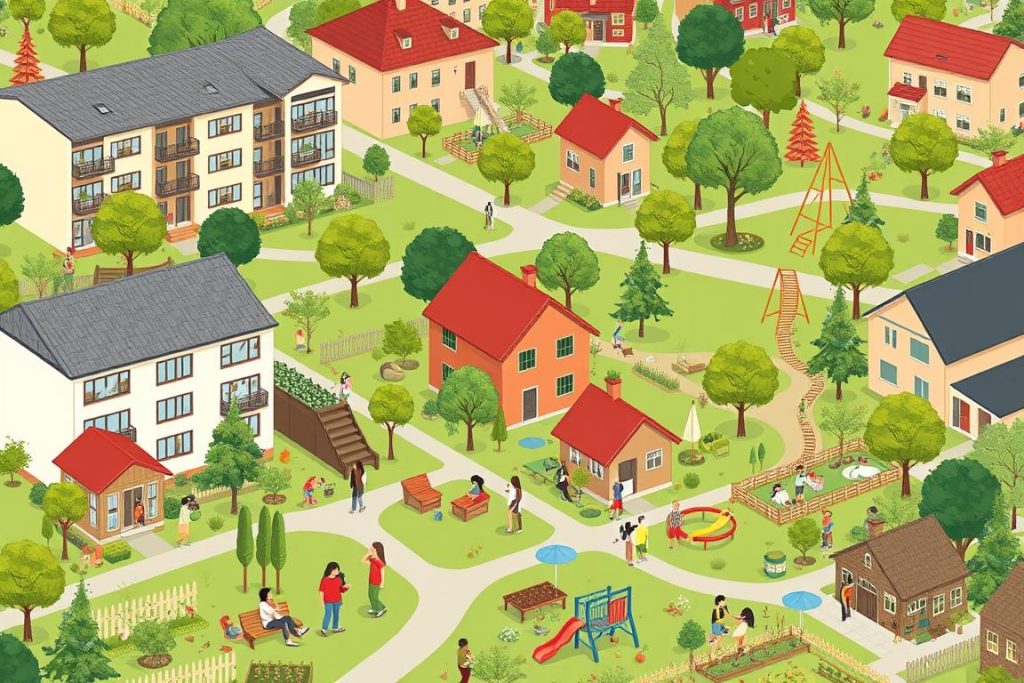Affordable Housing and Rental Assistance: How the Department of the Treasury Can Help
Did you know the Treasury has given out over $46 billion to help renters during the COVID-19 pandemic? This huge sum has funded more than 10 million payments to help renters avoid eviction. Many of these renters, especially those with low incomes or from communities of color, received crucial support.

The Treasury’s work goes beyond just giving money. They launched two big programs, ERA1 and ERA2, with $25 billion and $21.55 billion available. This money helps cover rent, overdue rent, utilities, and other expenses related to housing. The goal is to keep people in their homes and prevent homelessness.
The Treasury also plays a key role in making sure the money is used correctly. They guide states, territories, and local governments on using the funds to assist renters. Thanks to this effort, millions of Americans have avoided eviction. It’s a key part of making the economic recovery fair for everyone.
Key Takeaways
- The Treasury’s Emergency Rental Assistance programs have delivered over $46 billion to support housing stability during the COVID-19 pandemic.
- More than 10 million aid payments have been made to prevent evictions.
- ERA1 and ERA2 programs focus on providing comprehensive financial assistance, including rent and utility costs.
- Funds have primarily supported low-income renters and renters of color, fostering a more equitable recovery.
- The Consumer Financial Protection Bureau hosts an interagency portal for detailed information on emergency rental assistance.
- The Treasury’s guidance has been pivotal in enabling states, territories, and local governments to aid those in need effectively.
Overview of Affordable Housing Programs and Initiatives
Affordable housing programs help low-income families in many communities. They include emergency rental help, section 8 housing vouchers, and more low-income housing. These efforts make it easier for families to have a place to live.

Emergency Rental Assistance (ERA) Programs
The Emergency Rental Assistance programs are crucial for tenants with money troubles. ERA1 and ERA2 gave emergency funds to low-income households to keep them housed. With the American Rescue Plan Act, more money went into these programs.
There was a big focus on helping those in need quickly. ERA1’s funds were all used by December 2022. ERA2 kept the momentum going, spreading housing support far and wide.
American Rescue Plan Act and Housing Stability
The American Rescue Plan Act boosted money for affordable housing and vouchers. It helped with the economic effects of COVID-19. This made sure rental aid programs had enough resources.
This help stopped a lot of evictions. Public housing agencies used the funds wisely. They could use up to 20% of their Housing Choice Vouchers for stable homes. This fast aid was crucial for those most in need.
Impact on Low-Income and Marginalized Communities
Affordable housing efforts significantly help low-income and marginalized groups. Yet, many families still spend a lot on housing. The Housing Choice Voucher Program (Section 8) is vital for over 5 million people.
The Low-Income Housing Tax Credit (LIHTC) program is also key in making new affordable homes. It helps speed up solutions for low-income families.
Local governments have been working on affordable housing, too. They use programs and funds to make more housing affordable. As they work more on rental assistance, the situation should keep getting better. This means more fair housing for everyone.
Emergency Rental Assistance Funding and Distribution
The Treasury Department’s Emergency Rental Assistance (ERA) programs are key in supporting housing during the COVID-19 pandemic. They allocate funds to help renters and landlords facing challenges. This section covers the ERA1 and ERA2 programs, the COVID-19 relief package, and how these funds are used.
ERA1 and ERA2 Programs
ERA1 and ERA2 are two main programs in the ERA effort. Together, they’ve given out $46.55 billion to help with rent and keep people housed. These funds stop evictions and help keep housing stable during the pandemic. A unique part of these programs is they can be tailored to fit local needs.
Those who qualify can get up to 12 months of back rent and 3 months more of help. You need to show financial stress from COVID-19, including proof of where you live, how much you make, and your rent. Priority goes to those making less than 80% of the local median income. Funds are given out first-come, first-served, as long as there’s money.
COVID-19 Relief Package
The COVID-19 relief act in December 2020 and the American Rescue Plan Act were crucial. They stopped evictions and provided important housing aid in these hard times. The ERA funds go to tenants or landlords to ease their financial burdens.

ERA funds target the housing crisis made worse by the pandemic. To be eligible, you must have lost your job or income due to COVID-19 after March 13, 2020. You don’t need legal immigration status to apply, making it available to more people.
Allocation and Utilization of Funds
The Treasury Department keeps a close eye on how ERA funds are used through a dashboard. This ensures the money is used right and gets to those in need quickly. States and local programs distribute billions to assist renters.
Examples include support in Hempstead, Islip, and Oyster Bay for those earning up to 80% of the local median income. If your income is higher, you might not qualify for some ERA programs. Applications sent before the ERAP portal closed on January 20, 2023, are still being reviewed.
| Program | Assistance Provided | Eligibility |
|---|---|---|
| ERA1 | Up to 12 months of rental arrears and 3 months additional assistance | Income below 80% of area median income, COVID-19 financial impact |
| ERA2 | Similar to ERA1 with additional flexibility | Expanded to include higher income thresholds in some states |
| State & Local Programs | Varies by location, additional legal aid resources available | Based on local criteria, often similar to ERA guidelines |
The Treasury ERA program’s thorough approach means rent and utility help are given out well. This keeps housing stable in the community during and after the COVID-19 crisis.
Housing Assistance Through the Department of the Treasury
The Department of the Treasury is key in helping with housing for renters and landlords. It works to keep housing stable and affordable. Various programs help ease financial stress and avoid eviction or foreclosure.
Support for Renters and Landlords
The Treasury offers strong support for renters and landlords through the Emergency Rental Assistance (ERA) programs. These initiatives focus on housing stability by giving rental help and paying back rent. This is important to stop evictions and keep renters in their homes. Landlords also get the money they’re owed, which helps them keep offering affordable places to live.
Resources and Guidance Provided
The Treasury keeps people informed about housing aid with regular updates and advice. It gives tools for checking income and making sure rules are followed. There are key resources like the Compliance Supplement and Self-Service Resource. Resources for specific groups, like Tribes, include ID verification through ID.me and webinars.
Data and Research on Housing Stability
Research and data are crucial for the Treasury to keep housing stable. Studies show the Homeowner Assistance Fund (HAF) has greatly helped during the COVID-19 pandemic. By 2022, the HAF has helped over 230,000 homeowners. This includes a lot of support for very low-income folks, people of color, and women.
Here’s what the Homeowner Assistance Fund (HAF) programs have achieved:
| Key Statistic | Details |
|---|---|
| Total Funds Authorized | $9.961 billion |
| Homeowners Assisted | 230,000+ |
| Foreclosure Prevention | 500,000+ families |
| Specific Timeframes | 300,000+ families in homes by July 2023; nearly 400,000 by October 2023 |
There’s a strong ongoing effort for housing support. Updates like the Compliance Supplement and better self-service tools make a big difference. These steps help a lot in making housing more stable. They also work towards a fair recovery from the pandemic by addressing economic and racial gaps.
Conclusion
The Department of the Treasury has played a key role during the tough times of the COVID-19 pandemic. It has used programs like ERA1, ERA2, and the American Rescue Plan Act to help people keep their homes. These efforts have really made a difference, giving needed aid to both renters and landlords and preventing evictions.
Safe and stable housing is vital for public health, the data shows. Bad housing can hurt people’s health, showing how important good living conditions are. Housing First and similar programs have helped a lot. They’ve not only helped people stay in their homes but also cut down on health and service costs.
The Treasury’s clear reporting and research updates have set an example for fair housing policies. They’ve taken on the challenge of low wage growth and high rents, especially in cities. Their work aims to lessen the economic inequalities that lead to housing instability. The Treasury’s actions show a strong commitment to improving housing for everyone in the U.S.

